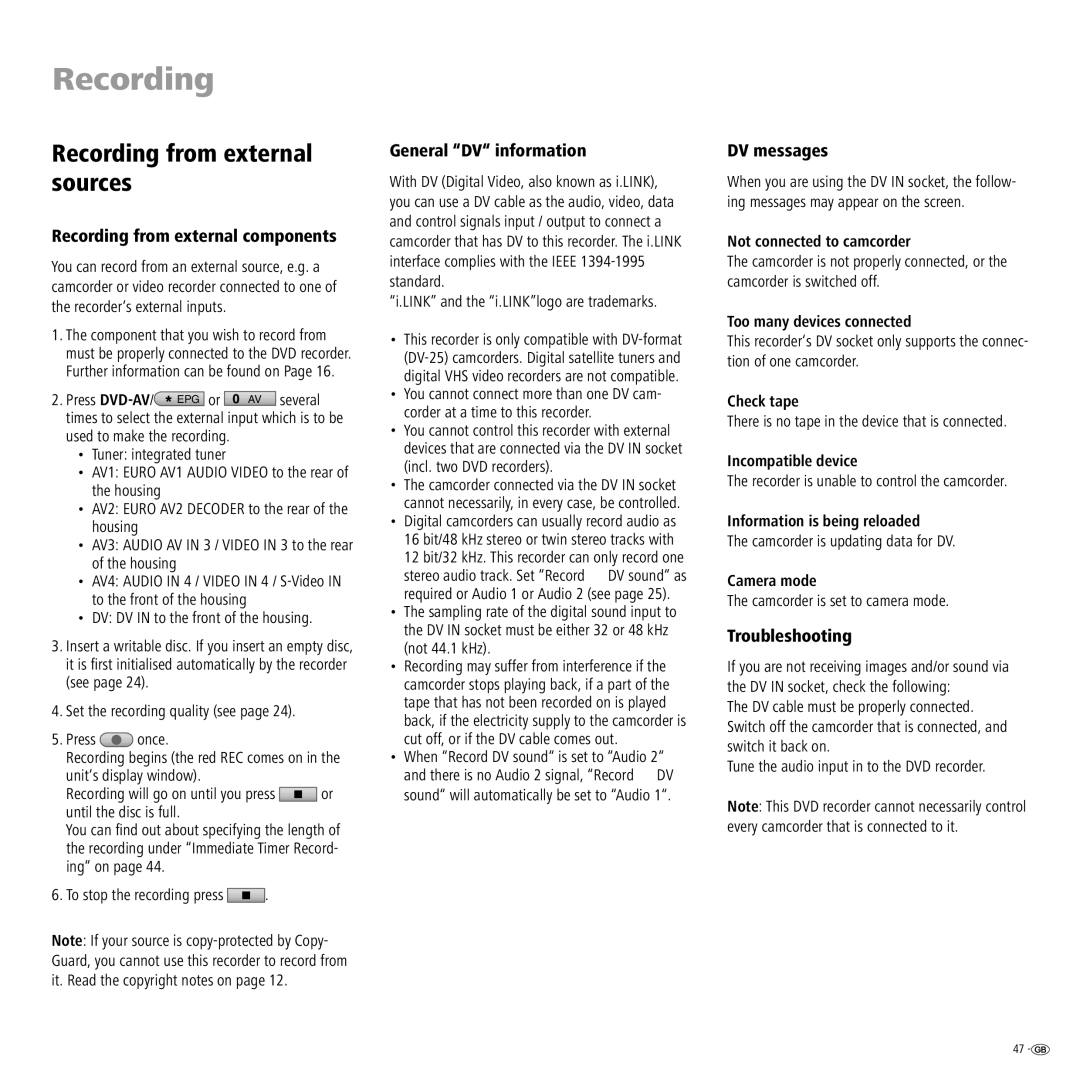
Recording
Recording from external sources
Recording from external components
You can record from an external source, e.g. a camcorder or video recorder connected to one of the recorder‘s external inputs.
1.The component that you wish to record from must be properly connected to the DVD recorder. Further information can be found on Page 16.
2. Press ![]() EPG or
EPG or ![]()
![]() AV several times to select the external input which is to be used to make the recording.
AV several times to select the external input which is to be used to make the recording.
•Tuner: integrated tuner
•AV1: EURO AV1 AUDIO VIDEO to the rear of the housing
•AV2: EURO AV2 DECODER to the rear of the housing
•AV3: AUDIO AV IN 3 / VIDEO IN 3 to the rear of the housing
•AV4: AUDIO IN 4 / VIDEO IN 4 /
•DV: DV IN to the front of the housing.
3.Insert a writable disc. If you insert an empty disc, it is fi rst initialised automatically by the recorder (see page 24).
4.Set the recording quality (see page 24).
5.Press ![]() once.
once.
Recording begins (the red REC comes on in the unit‘s display window).
Recording will go on until you press ![]() or until the disc is full.
or until the disc is full.
You can fi nd out about specifying the length of the recording under “Immediate Timer Record- ing“ on page 44.
6.To stop the recording press ![]() .
.
Note: If your source is
General “DV“ information
With DV (Digital Video, also known as i.LINK), you can use a DV cable as the audio, video, data and control signals input / output to connect a camcorder that has DV to this recorder. The i.LINK interface complies with the IEEE
“i.LINK” and the “i.LINK”logo are trademarks.
•This recorder is only compatible with
•You cannot connect more than one DV cam- corder at a time to this recorder.
•You cannot control this recorder with external devices that are connected via the DV IN socket (incl. two DVD recorders).
•The camcorder connected via the DV IN socket cannot necessarily, in every case, be controlled.
•Digital camcorders can usually record audio as 16 bit/48 kHz stereo or twin stereo tracks with 12 bit/32 kHz. This recorder can only record one stereo audio track. Set “Record ➜ DV sound“ as required or Audio 1 or Audio 2 (see page 25).
•The sampling rate of the digital sound input to the DV IN socket must be either 32 or 48 kHz (not 44.1 kHz).
•Recording may suffer from interference if the camcorder stops playing back, if a part of the tape that has not been recorded on is played back, if the electricity supply to the camcorder is cut off, or if the DV cable comes out.
•When “Record DV sound“ is set to “Audio 2“ and there is no Audio 2 signal, “Record ➜ DV sound“ will automatically be set to “Audio 1“.
DV messages
When you are using the DV IN socket, the follow- ing messages may appear on the screen.
Not connected to camcorder
The camcorder is not properly connected, or the camcorder is switched off.
Too many devices connected
This recorder‘s DV socket only supports the connec- tion of one camcorder.
Check tape
There is no tape in the device that is connected.
Incompatible device
The recorder is unable to control the camcorder.
Information is being reloaded
The camcorder is updating data for DV.
Camera mode
The camcorder is set to camera mode.
Troubleshooting
If you are not receiving images and/or sound via the DV IN socket, check the following:
The DV cable must be properly connected. Switch off the camcorder that is connected, and switch it back on.
Tune the audio input in to the DVD recorder.
Note: This DVD recorder cannot necessarily control every camcorder that is connected to it.
47 ![]()
